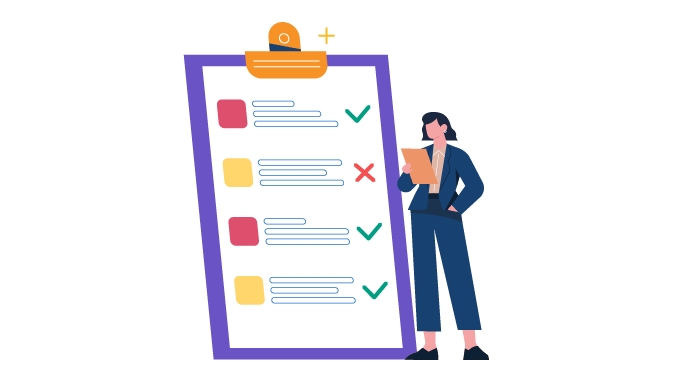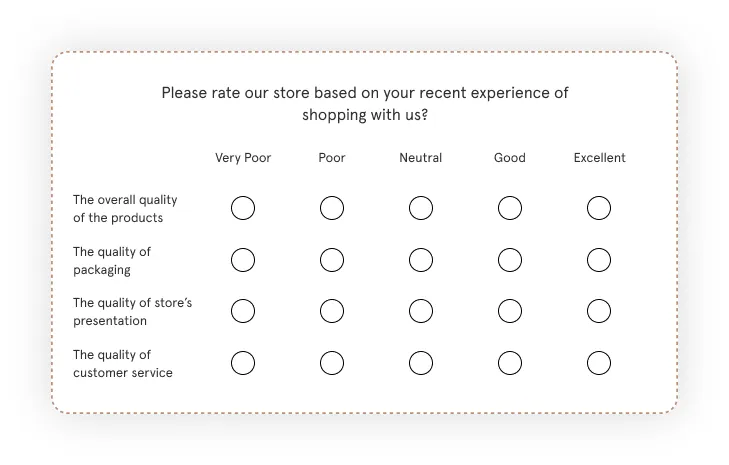How Does an Employee Benefits Survey Help a Company Grow?
There's a science to selecting benefits that effectively balance employer budgets and employee priorities.
An interactive employee benefits survey is your secret to achieving this elusive synergy.
The right questions blueprint your people's benefits outlook, including satisfaction, pain points, and desired additions.
This intel will shape offerings to reflect what your workforce wants most for their well-being, finances, and career.
In this post, we'll dive into 10 survey questions that will transform your benefits plan into a strategic driver of engagement, productivity, and loyalty.
Let's unlock powerful insights to guide smarter investments by simply listening to employees.
* If offered access to more benefits, 73% of employees would be encouraged to stay with their current employer for longer (MetLife)
* If offered access to more benefits, 73% of employees would be encouraged to stay with their current employer for longer (MetLife)
The stats show that employees have always been and will be inclined towards better benefits instead of work, efforts, and involvement in a professional workspace.
The data shows that 73% of staff would stay longer at a company if offered enhanced benefits versus seeking opportunities elsewhere.
This highlights a major chance for strategic additions supporting financial wellness, flexibility, and health - even modest - to aid recruitment and loyalty.
With turnover so costly, businesses making progressive benefits investments that boost engagement and productivity will stand out.
What are Employee Benefits Surveys?

Employee benefits surveys are questionnaires designed to gather feedback and insights directly from an organization's staff regarding the employee benefits programs offered to them.
They aim to assess employees' satisfaction, preferences, and future needs related to benefits.
Benefits include health insurance, retirement plans, flexible work arrangements, professional development stipends, and other offerings to support well-being and life outside work.
Questions probe the perceived value and desired improvements for new and potential benefits.
In simple terms, employee benefits survey acts as a pulse survey, gauging satisfaction and needs swiftly. Pulse survey is a huge domain that cover all aspects of the organizations and employee's perspectives and satisfaction levels. To know more about it, read through our comprehensive guide on Pulse Surveys.
Why Are They Important?
- Employee benefits are crucial for attracting top talent and maintaining high job satisfaction, pivotal in retaining employees, and fostering a positive company culture.
- These surveys gather direct feedback from your people about what health plans, wellness options, work-life supports, and other perks resonate most.
- The interactive process gives employees a platform for input on priorities and challenges.
- Simultaneously, it provides leadership with a data treasure trove to inform benefits decision-making with pinpoint precision no guesswork can match.
In short, employee benefits surveys achieve the coveted win-win.
Organizational responsiveness to employee feedback leads to higher retention rates, lower absenteeism, improved productivity, better customer service and higher employee morale. The fact that the organization is conducting a survey can send a positive message to employees that their opinions are valued.
– SHRM
So, what’s the benefit to employers from such surveys?
- Employers can leverage survey data on employee benefits to tailor offerings that resonate with their workforce, fostering higher satisfaction and retention.
- Analyzing this data helps identify preferences, allowing for strategic adjustments, cost-effective benefit allocation, and a competitive edge in attracting top talent.
- This aligns the benefits package with employees' evolving needs and preferences for a more engaged and productive workforce.
- Employers also get to optimize limited budgets to drive engagement, productivity, and retention.
And what’s the benefit to employees?
- Employees feel truly heard, valued, and cared for through support tailored to their needs.
- Employee benefit surveys empower companies to understand employees' needs and desires, enabling tailored benefits packages.
- By gathering feedback, employers can refine benefits, address specific needs, increase job satisfaction, and demonstrate a commitment to employee well-being.
- This process boosts morale, engagement, and loyalty, fostering a happier, more satisfied workforce.
A recent employee benefits survey
employee benefits survey shows that while staples like health insurance, retirement plans, and paid time off remain highly valued by companies, wellness and education benefits are emerging priorities.
Employee Benefits Survey Questions

We've curated a few employee benefits survey questions to delve deeper into our valued workforce's nuanced needs and preferences.
This survey acts as a compass, guiding us toward tailoring benefits that resonate with individual aspirations, elevating job satisfaction, and fostering a culture of support.
Let’s take a quick glimpse at them.
Benefits Inquiry: General Queries
Determining employee satisfaction with the benefits provided and the need for potential updates is essential. These example questions serve as a starting point:
- Can you easily access [your company]'s benefits program? (Yes/No)
- Are you satisfied with the benefits provided by [your company]? (Yes/No)
- Do the benefits influence your decision to work here? (Short answer)
- Rate [your company]'s employee benefits plan on a scale of 0-5 for meeting your needs.
- Which benefits do you consider most important? (Short answer)
Healthcare Survey Questions
- Satisfaction:
- On a scale of 1-10, how satisfied are you with our current healthcare benefits?
- What aspects of our health benefits work well for you?
- What aspects of our health benefits are most frustrating or confusing?
- Coverage:
- How adequately do our health insurance plans cover your needs related to doctors’ visits, prescriptions, dental, vision, etc.?
- Are there any frequent healthcare expenses you pay mostly out-of-pocket?
- Do any of your family members lack coverage that you wish was provided?
- Wellness:
- How likely would you be to participate in employer-offered preventative health and wellness programs?
- What specific wellness initiatives should our organization invest more in for employees (e.g. mental health resources, fitness reimbursement, nutrition counseling, etc.)?
- Suggestions:
- Do you have suggestions on improving healthcare benefits for employees?
- What offerings from previous employers or other companies could we incorporate?
- Flexibility:
- How important are customized plans with options to meet your individual needs?
- Should our organization offer several carriers and plan levels to choose from?
Fitness and Gym Benefits Survey Questions
To understand the effectiveness and accessibility of fitness perks, consider these inquiries:
- Are you satisfied with [your company]'s new fitness plan? (Yes/No)
- Does the company’s gym membership offer financial benefits to you? (Yes/No)
- Is the reimbursement process for gym payments straightforward? (Yes/No)
- Do the fitness benefits align with your personal development goals? (Yes/No)
Retirement and Savings Survey Questions
Exploring the perception of retirement benefits, these questions shed light on employee sentiments:
- Do you find the company's contribution to retirement funds generous? (Yes/No)
- Are you content with the company’s retirement plan program? (Yes/No)
- Do you feel confident in understanding and accessing your retirement benefits? (Yes/No)
- If you could change one thing about the retirement plan, what would it be? (Short answer)
Professional Development and Tuition Investigation
- Uncovering insights into professional growth, consider these questions:
- Do you feel you have sufficient opportunities for growth while working here? (Yes/No)
- Does the employer provide a sufficient professional development allowance? (Yes/No)
- Do you feel empowered to explore new skills using your development allowance? (Yes/No)
- Do you understand the process for requesting training/tuition reimbursements? (Yes/No)
Parental Leave Inquiry
Assessing satisfaction with parental leave programs involves these questions:
- Rate [your company]'s parental leave program from 0-5 stars.
- Does your manager support balancing work and childcare responsibilities? (Yes/No)
- Does the parental leave program align with your needs? (Yes/No)
- Do you feel informed about your rights regarding parental leave? (Yes/No)
Benefit Satisfaction Questions
- I am satisfied with the current benefits package.
- I have received a fair benefits package for my job.
- How would you rate the benefits package?
- Use a ranking system ranging from “Extremely Satisfied to Extremely Disappointed.”
- This can be listed for specific benefits.
- Do you have any recommendations for future benefits we could offer?
The 6th Question is an open-ended one, so leave room for the employee to write in an answer
Childcare Benefits Survey Questions
Here are some sample employee benefits survey questions related to childcare:
-
How satisfied are you with the current childcare benefits offered?
-
How likely would you utilize an onsite daycare facility if made available at a subsidized rate?
- Which additional childcare benefits should be considered as part of our offerings? (Select all that apply)
- After school care
- Sick child care
- Summer care camps
- Flexible spending accounts for childcare expenses
- Childcare provider referrals
- Parenting workshops/seminars
-
On a scale of 1-5, how valuable would corporate discounted rates at childcare centers in your area be?
-
Which child-related needs are most difficult to address currently that employee benefits could potentially assist with? (Select top 3)
- Finding care for school holidays/teacher development days
- Managing pick ups/drop offs and schedules
- Locating trustworthy babysitters for dates and evenings out
- Obtaining care for mildly ill children
- Affording quality childcare arrangements
The goals are assessing current satisfaction, interest in potential new offerings, difficult challenges to address, and quantifying the perceived value of different childcare supports. Please let me know if you need any other examples!
Learning & Development Survey Questions
Here are some sample employee survey questions related to learning and development benefits:
- On a scale of 1-5, how satisfied are you with the current learning and development opportunities provided?
Where Very Dissatisfied ranks (1) and Very Satisfied ranks (5)
- How likely are you to take advantage of the following if offered?
Online courses and training modules
Where Very Unlikely ranks (1) and Very Likely ranks (5)
Full tuition reimbursement for advanced certifications or degrees
Where Very Unlikely ranks (1) and Very Likely ranks (5)
- Which additional professional growth and skills training options should the company explore offering? (Select all that apply)
- Executive Coaching
- Bootcamps in high-demand skills like data fluency
- Rotational assignments
- Mentor matching
- Monthly skill-building workshops
- External conferences and events
- I am provided adequate resources and support to develop my capabilities for career advancement.
Where Strongly Disagree ranks (1) and Strongly Agree ranks (5)
- What barriers do you face in achieving your professional development goals? (Select all)
- Cost/budget limitations
- Lack of time
- Unsure where to start
- Information overload
- Manager discouragement
The goals are to evaluate current programming, quantify demand for potential new offerings, uncover growth barriers, and identify employees' priorities for support.
Demographic Survey Questions
The key categories often used to segment demographics include age, gender identity, location/geography, industry, department, tenure, role seniority, and education level.
This allows comparing and analyzing how survey responses may differ across demographic factors.
They provide the demographic context around various attitudes and behaviors reported.
Here are 4 common demographic question examples to include in surveys:
- Age
What is your age?
Under 18
- 18-24
- 25-34
- 35-44
- 45-54
- 55-64
- 65 or older
- Gender
What gender do you identify as?
- Male
- Female
- Transgender
- Non-binary
- Prefer not to say
- Location
What region do you live in?
- Northeast
- Southeast
- Midwest
- Southwest
- West Coast
- Other (please specify)
- Industry
What industry is most relevant to your job?
- Healthcare
- Education
- Government
- Manufacturing
- Hospitality
- Marketing & Communications
- Information Technology
- Other (please specify)
Employee Benefits Survey Question Types

1. Scale Questions
Scales allow for gathering quantitative data and charting the average and variability of responses. You can customize scale labels (1-10, Very Dissatisfied - Very Satisfied, etc.).
-
- How do you rate our health insurance benefits?
-
- How do you rate our sick leave policies?
-
- How do you rate our flexible work arrangements?
-
- Please rate each benefit by personal importance.
-
- How satisfied are you with our paid time off policy?
-
- Are our professional development options adequate?
-
- Our benefits package seems to match industry standards.
-
- How frequently have you utilized our insurance plans?
-
- How often do you take advantage of the lunch subsidy perk?
-
- I understand all the benefits offered currently.
2. Likert Scale
A Likert scale is a commonly used rating system in surveys that allows respondents to express their degree of agreement or disagreement with a given statement.
The key hallmarks of Likert scale questions are offering a set rating scale (typically 5 or 7 points) with clear, descriptive anchors attached to numeric responses.
This allows quantifying attitudes, perceptions, and behaviors in survey analysis.
Here are some examples of Likert scale questions for an employee benefits survey from the employee perspective:
- Satisfaction
On a scale of 1-5, how satisfied are you with the overall benefits package offered at this company? (1 = very dissatisfied, 5 = very satisfied)
How favorably does our medical insurance compare to previous employers you've had? (1 = much worse, 5 = much better)
- Importance
Rate the importance of the following benefits to you on a scale of 1-5. (1 = not at all important, 5 = extremely important)
- Health insurance
- Retirement savings plan
- Flexible work schedules
- Professional development funds
Engagement
The benefits package here positively impacts my engagement and loyalty to the company. (1 = strongly disagree, 5 = strongly agree)
Employee Well-being
The benefits show this company genuinely cares about employee well-being and satisfaction. (1 = strongly disagree, 5 = strongly agree)
Communication
-
The process and requirements to use my benefits are clearly communicated. (1 = strongly disagree, 5 = strongly agree)
-
Onboarding effectively explained all benefits available to me as a new employee. (1 = strongly disagree, 5 = strongly agree)
3. Open-Ended Questions
Open-ended questions elicit detailed qualitative insights. For example, you can uncover specifics on improving health plans or evaluate the value of a little-used benefit.
- What aspect of our benefits package works best, and why?
- If possible, what element would you change and why?
- Do any parts of the current package concern you?
- Which benefits hold the most value for you?
- Should we consider modifying or adding any benefits?
- Are there other leading companies with strong benefits we should emulate?
- What flexible work policy adjustments do you suggest?
- Remainder of questions
4. Multiple Choice Questions
Multiple choice questions are another common survey format that is useful for employee benefits surveys.
The survey provides predetermined answer options for respondents to multi-select in the given questions.
Here are some examples of multiple-choice employee benefits survey questions:
- Which of the following voluntary benefits our company offers do you currently participate in or enroll in? (Select all that apply)
- Pet insurance
- Legal services
- Identity theft protection
- Home and auto insurance
- I do not participate in any voluntary benefits
- If the company were to offer an Employee Stock Purchase Plan (ESPP), what is the likely level of participation you would have?
- Full participation in every offering period
- Occasional participation
- Would not participate
- Unsure
- Where do you find information regarding health insurance plans, networks, and claim submissions?
- Direct supervisor
- Internal benefits website
- Insurance carrier member portal
- External search engines
- Which additional Employee Assistance Program support areas would provide you the most value?
- Mental wellbeing
- Work-life balance
- Parenting and eldercare
- Financial coaching
- Physical health
As shown above, well-designed multiple choice questions allow learning specifically which pre-determined options and features employees express interest in or currently utilize.
This generates actionable data that benefits decision-makers.
Employee Benefits Survey Template

Many such templates are available that offer an organization exactly what they need. Discover a new level of survey customization with Vantage Pulse.
Whether you prefer ready-made or personalized surveys, it empowers organizations to effortlessly capture nuanced employee preferences, optimizing benefits for satisfaction and engagement.
Tips for Creating an Effective Employee Benefits Survey

-
Clear Objectives:
Clearly define the purpose and goals of the survey to guide both the creators and respondents effectively. -
Engaging Design:
Opt for a visually appealing, user-friendly layout to enhance respondent engagement and completion rates. -
Relevant Questions:
Craft questions that directly align with the survey's objectives, ensuring meaningful and actionable data. -
Inclusive Language:
Use inclusive and neutral language to make the survey accessible and relevant to a diverse audience. -
Pilot Testing:
Conduct a small-scale pilot test to identify and address any issues with survey design or clarity before widespread distribution.
In addition to understanding how employee benefits surveys function as pulse surveys, delve into our beginner's guide for a comprehensive overview. Learn essential tips, from setting clear objectives to crafting inclusive questions, ensuring your surveys yield valuable insights.
How to Analyze Employee Benefits Survey Data

-
The goal of employee engagement survey analysis is to unravel the heartbeat of the workplace. We also have a blog that talks about the employee engagement survey questions that an organization can ask.
-
It seeks to decode the nuances of employee sentiments, uncovering hidden patterns and insights that can fuel strategic initiatives.
-
By delving into survey data, organizations aim to sculpt an environment that retains top talent and propels the entire workforce toward heightened productivity and fulfillment.
-
Analyzing the data you collect from employee feedback helps you notice patterns, challenges, and problems, which you can then find solutions to and implement across the organization.
-
This data is highly valuable, but only if it’s collected and analyzed effectively and if action is taken.
-
However, as important as it is to collect timely surveys, is equally necessary to take action to justify the purpose of the surveys.
-
If the management is all talk and no action, employees will eventually get more disengaged. It is important to back up surveys with strategies and solutions based on the output.
Common Mistakes to Avoid in Survey Data Analysis
How a survey question is phrased can influence how participants view a topic and even inadvertently compel inaccurate responses.
So, the goal is to craft neutral questions that capture authentic perspectives without guiding respondents or unintentionally skewing data.
Carefully considering the framing and flow of each question ensures clarity for the people taking your survey and actionable input for you.
Here are some common mistakes to avoid when analyzing employee benefits survey data:
-
Not cleaning the data - Typos, duplicate responses, and incomplete surveys can skew results. Always scrub data first.
-
Ignoring outliers - Don't automatically discard statistical outliers without investigation, as they may reveal issues.
-
Getting lost in granularity - While slicing data by segments has value, don't miss overarching themes.
-
Lacking context - Supplementary data on cost, utilization, etc., enriches and contextualizes self-reported survey responses.
-
Making causal inferences - Surveys show correlations in attitudes and behaviors, not definitive causation.
-
Overgeneralization - Data indicates tendencies for the sample size, not absolute truths for the population.
-
Disorganization - Methodically catalog insights revealed, audiences to share findings with, follow-ups needed, etc.
-
Failing to share results - Survey participation depends on demonstrating you act on feedback with transparency.
-
No iteration - Continually reviewing and refreshing survey questions prevent bias or outdated lines of inquiry.
-
Lack of objective support - Consult experts like benefits consultants or statisticians to bolster the validity of the analysis.
Avoiding these missteps ensures employee benefits survey data analysis yields accurate, actionable insights leadership can confidently base decisions on.
Moving on…;
Using Survey Results to Optimize Benefits Offerings

Regular employee benefits surveys only reveal moment-in-time insights. You must embed findings into continuous, long-range HR strategic planning to optimize value.
This transforms one-off surveys into catalysts for compounding returns over time - from reduced turnover to controlling costs to boosting productivity and recruitment messaging.
-
Use Results to Inform Annual Planning-
Analyze results during the yearly benefits selection process to guide decisions on carriers, offerings, and investment levels. Track satisfaction metrics over multi-year periods. -
Set 3-5 Year Targets-
Identify 2-3 priority areas for benefits enhancements based on the feedback over a 3-5 year horizon for incremental improvements. -
Create Personalization Roadmaps-
The map needs that allow for enhanced customization and flexible benefits selection for different employee personas over time. -
Connect Data to Recruitment Messaging-
Quantify and promote stand-out benefits that surveys indicate are effective recruiting sweeteners to retain competitiveness. -
Feed Insights into Employee Value Proposition Development-
Let employee-voiced benefits priorities shape EVP and employer branding. -
Build a Culture of Listening & Responding-
Closing feedback loops shows commitment to acting on findings and makes workers feel heard.
Case Studies
"We know that our employees have many choices about where they work, so we work to ensure that they are very well compensated," a Google spokesperson said in a statement to CNET. "That's why we've always provided top of market compensation across salary, equity, leave, and a suite of benefits. Getting employee feedback is important and we'll continue to ensure we pay competitively everywhere our employees work and help them grow their careers at Google."
Google Spokesperson
As a leading global hospitality company operating hotels worldwide, Hilton Worldwide Holdings receives strong employer ratings for its focus on diversity, inclusion, and providing discounted hotel stays for employees. With remote work options and healthcare benefits, Hilton aims to support its workforce while enabling career development and advancement opportunities.
Reviews praise managerial care for employees, competitive salaries, and excellent overall benefits. Despite some critique on PTO policies for newer staff, happy team members highlight perks like room discounts driving a positive employee experience. Overall, Hilton strives to empower employees through work culture, travel benefits, and supportive leadership.
Conclusion
Conducting employee benefits surveys enables crucial workforce feedback. The findings provide insights into satisfaction levels and value of offerings to guide better spending decisions.
Regular surveys support a listening culture where employees feel heard and valued. This drives engagement, productivity, and retention - essential for both worker wellbeing and organizational success. View surveys as an ongoing enhancement tool to shape a top-rated compensation and benefits experience.














